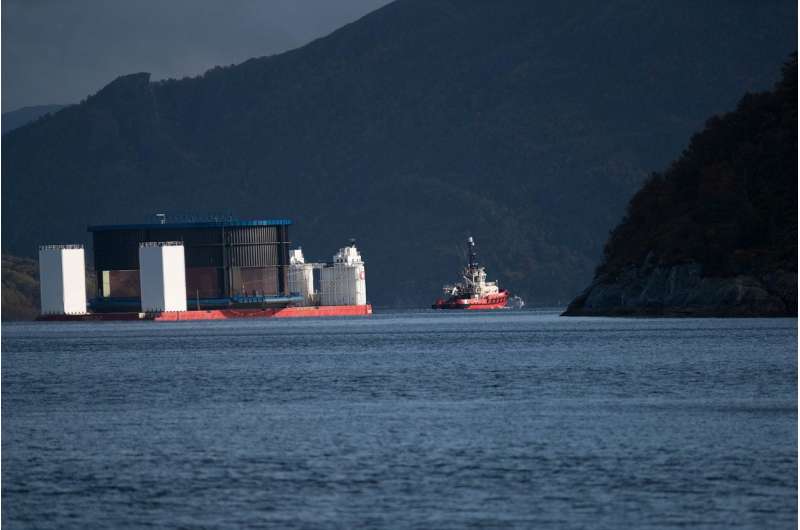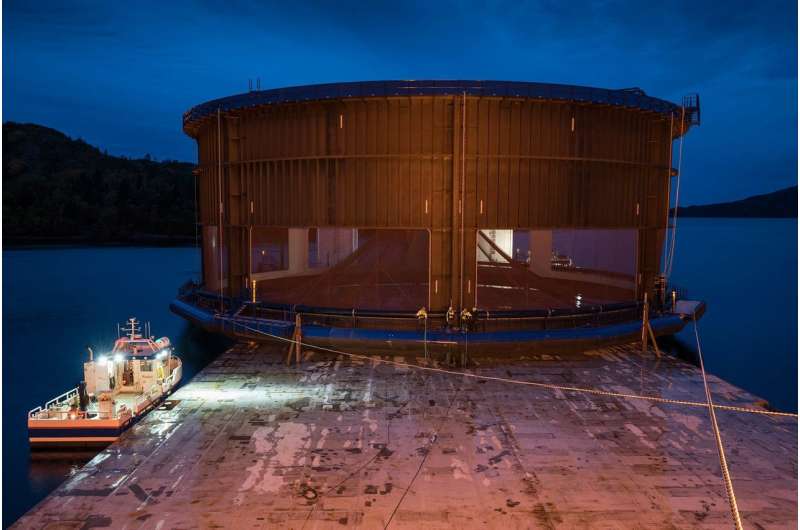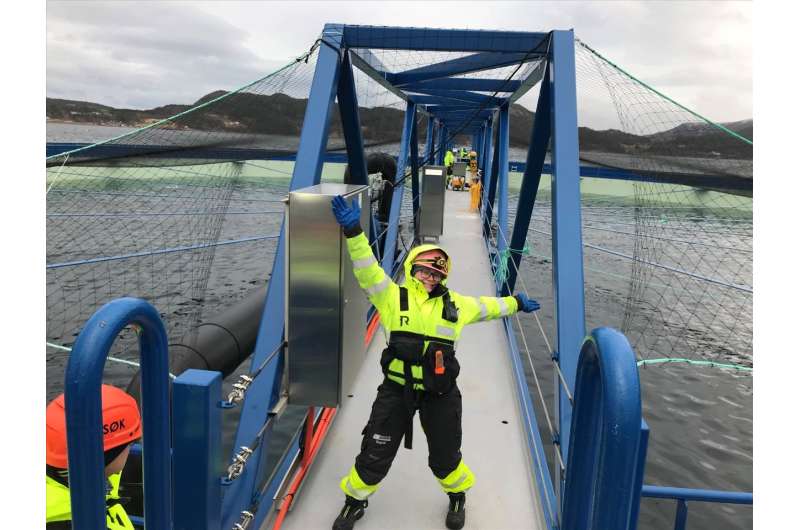A new, escape-proof fish cage for a lice-free salmon farm

In October this year, the first salmon were farmed in a new fish production prototype in Trøndelag, Norway. With a rigid steel construction and a water current generator, the new Aquatraz fish cage both prevents fish escape and keeps the fish in shape, while researchers from the Norwegian Institute for Water Research (NIVA) are monitoring the sea lice and water quality in the cage.
The name of the new cage concept is inspired by the high-security prison Alcatraz on Alcatraz Island in the San Francisco Bay, from which no prisoner could escape. The goal is that the fish prison will be just as escape proof —and hopefully, house less sea lice.
"It is both an honour, and very interesting, to be a part of this project," says researcher Sara Calabrese at the Norwegian Institute for Water Research (NIVA).
She and her colleague Anders Hobæk are back from their first water sampling at Aquatraz. The cage is located in Eiterfjorden, north in Trøndelag county, Norway. The coming year, NIVA will monitor the aquatic environment in the cage.
Lice skirt made of steel
Aquatraz is a result of cooperation between the company Midt-Norsk Havbruk and Seafarming Systems. The cage is 18 meters deep, has a circumference of 160 meters, and it has a new design never tested before: The whole cage can be lifted above sea level, the water is supplied from the deeper layers, and the lice skirt is made of steel.
"The eight uppermost meters of the cage is enclosed by a wall. This wall prevents the lice from getting into the cage, as sea lice usually live in the upper meters of the water column," Calabrese explains. She did her Ph.D. on semi-closed aquaculture systems like Aquatraz.

The wall, or lice skirt, as it is called in fish farming terminology, is made of steel, and is more resistant to deformation and mechanical impacts from the surrounding environment than conventional lice skirts. Avoiding deformation of the skirt reduces the risk of surface water leakage into the cage—and thereby leakage of lice and potentially other harmful waterborne organisms like microalgae.
"The aim is to keep the sea lice away. We will compare the presence of lice, microalgae and jellyfish in the Aquatraz cage, in a traditional sea-cage next to Aquatraz, and in the influent waters to investigate the effect of the newly designed cage," Calabrese explains.
Water chemistry, temperature, oxygen content, and water current will also be investigated by NIVA. By comparing fish welfare, fish health and fish growth in the new and old cage, the researchers will assess the effects of water quality and technical solutions on salmon and presence of lice.
Water from the deep and fish exercise
The water quality is dependent on a range of factors, says the NIVA researcher. "How deep does the skirt go, where does the water come from and how quickly is it exchanged? How many fish are in the cage, and how much feed are they fed? Additionally, winds, precipitation, and ocean stratification influence the water quality in the cage —to mention some factors."
In the new Aquatraz cage, some of the outer factors are controlled: The design of the cage and using water current generators inside the cage pull deeper water into the cage and increase the water exchange rate. As water from a deeper origin often contains more oxygen than water from the upper water layers, the salmon gets fresher water than if the water supply was from passive transport through the cage only. The deep-water supply also ensures less variation in water temperature in the cage. Using a water current generator inside the cage will not only increase the water exchange rate, keeping water fresh, it will also exercise the fish as they continually have to swim against the current. This keeps the fish healthy and growing.

Instead of a water current generator, the conventional Midt-Norsk cage has a so-called midtnorsk ring. This ring is situated at the bottom of the cage. Air bubbles are released from the ring, pulling deep water upward and mixing the water masses. In Aquatraz, this ring is only a back-up.
"I'm excited to see the effects of the water current generators and the design of Aquatraz on sea lice abundance and water quality, and to see how big the difference is from the conventional cage," Calabrese says.
Additional Aquatraz cages are on their way
This is the first out of four planned Aquatraz cages, and there will be more. The second one is already under construction at Fosen Yard in Indre Fosen municipality, and will be towed to its sister cage in Eiterfjorden as soon as it is finished, by the end of December. NIVA's monitoring of the water quality will contribute so that every new cage will be a little better than the previous one.
"Good water quality is essential for fish health and -growth, just like good air quality is essential for us humans. By systematically comparing new technology with conventional methods, followed up by improved technology and routines, Aquatraz is an important project on the pathway to tackling the major challenges within aquaculture today, namely sea lice, fish escapes and mortality," the NIVA researcher concludes.
Provided by Norwegian Institute for Water Research (NIVA)












.jpg)
.jpg)







